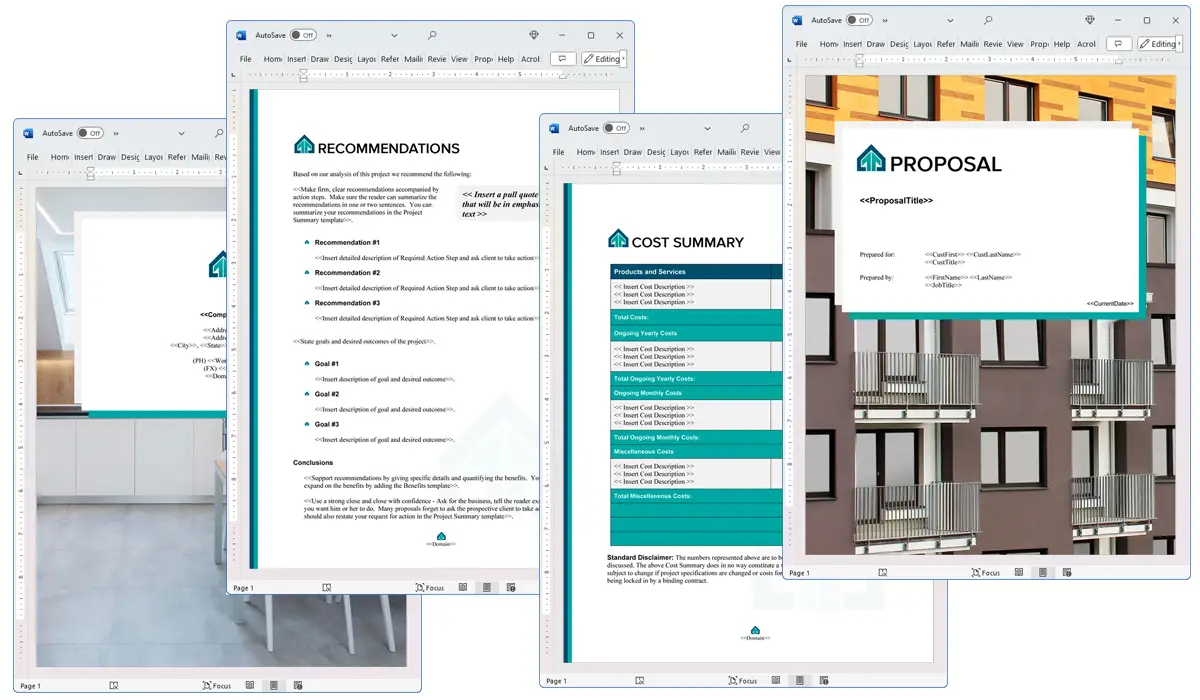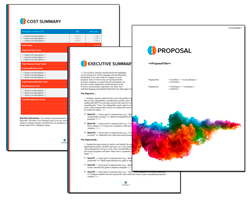What is the Capacity chapter used for?
Proposal Kit Professional Bundle adds more design themes, all six Contract Packs,
a project management library, and Expert Edition software.

Illustration of Proposal Pack Real Estate #8
We include this Capacity chapter template in every Proposal Pack, along with thousands more. You assemble this chapter with others in various combinations to create custom-tailored business proposals, plans, reports, and other documents. Proposal Packs apply custom visual designs to the templates, giving the final documents a consistent professional finish.
 DOWNLOADABLE, ONE-TIME COST, NO SUBSCRIPTION FEES
DOWNLOADABLE, ONE-TIME COST, NO SUBSCRIPTION FEES
Overview of the Capacity Chapter
The Capacity chapter is an important part of the Proposal Kit system, used to communicate the potential and limitations of a business in fulfilling the requirements of a proposed project or service. This chapter helps organizations articulate their ability to handle the demands of the project, making clear the extents of their workforce, resources, and operational capabilities.
How is the Capacity Chapter Used?
In a business proposal, the Capacity chapter is used to instill confidence in potential clients or partners about the proposing company's ability to meet project demands. It serves to provide a clear and concise presentation of the company's resources and operational strengths. By detailing the company's capacity, this chapter addresses potential concerns about performance and scalability, thus playing a role in the decision-making process of the proposal recipient.
What is Included in the Capacity Chapter?
Typically, the Capacity chapter will include:
- An overview of the company's total workforce, including key personnel and their expertise.
- Information on physical and technical infrastructure that supports the company's operations.
- Details regarding production capabilities, such as maximum output volumes and turnaround times.
- Information on any logistical or supply chain factors that might affect project execution.
- Descriptions of past projects or experiences that demonstrate the company's capacity to manage and complete projects successfully.
Use Case Examples for the Capacity Chapter
The Capacity chapter can be adapted to suit various types of proposals. Below are a few use case examples:
- Automation: Detailing the company's capability in managing and executing automation projects with specifics on technological and manpower resources.
- Manufacturing: Demonstrating the company's production capacity, including specifics on machinery, workforce, and output efficiency.
- Fabrication: Showing the extent of the company's expertise in fabrication, including details on custom projects and scalability of operations.
- Non-Profits: Illustrating the organization's capability to handle large-scale initiatives, detailing volunteer workforce and operational logistics.
- About Your Company: When used in a general company introduction, it can outline overall capacity in various operational areas to provide a comprehensive view of the company's capabilities.
Key Takeaways
- The Capacity chapter is important for showcasing a company's ability to meet the demands of a project.
- It helps build trust with potential clients by transparently communicating the company's operational strengths and limitations.
- This chapter includes detailed information about workforce, production capabilities, and infrastructural support.
- It can be customized for different types of proposals, such as automation, manufacturing, and non-profit projects.
- Proper use of the Capacity chapter can significantly influence the success of a business proposal by addressing potential concerns about performance and scalability.

Illustration of Proposal Pack Artsy #12
 What Our Clients Say
What Our Clients SayThanks for the great service your company has provided. I had a very important sales proposal to prepare for a realty firm, and was given only a 1-day notice. I purchased and downloaded the sales proposal [Proposal Pack] with the Real Estate design, and it was exactly what I needed. The forms were perfect, and the presentation went great. We were told it was the best she had ever seen. Thanks for a great product, and for providing it in a pinch!"
Managing Director/President
Breakwater Mortgage Corp.
 4.7 stars, based on 849 reviews
4.7 stars, based on 849 reviewsRelated Chapters
Samples Using the Capacity Chapter
Document Layouts Using the Capacity Chapter
- Reusable Component Design Proposal
- Community Center Funding Proposal
- Beverage or Food Manufacturing Project Proposal
- Industrial Automation Proposal
- Animal Farming Startup Proposal
- Water Treatment Plant Project Proposal
- Automation of Facilities and Production Proposal
- Group Home for People with Disabilities Proposal
- Live Entertainment Proposal
- Call Center Startup Funding Proposal
- Teen Center Funding Proposal
- Product Manufacturing Project Proposal
- Sustainable Energy Production Facility Proposal
- Equipment Operation and Maintenance for Water Production Proposal
- Biogas Project Proposal
- Supply Chain Logistics Project Proposal
- Restaurant and Bar Funding Proposal
- Healthcare Workshop and Conference Proposal
- Cloud Computing Services Proposal
- Mining Production Proposal
- And more like these

The Capacity chapter and other chapters are integrated into a Word document as illustrated here in the Proposal Pack Artsy #12 design theme. There are hundreds of design themes available, and every design theme includes the Capacity chapter template.
A proper business proposal will include multiple chapters. This chapter is just one of many you can build into your proposal. We include the complete fill-in-the-blank template in our Proposal Pack template collections. We also include a library of sample proposals illustrating how companies in different industries, both large and small, have written proposals using our Proposal Packs. This template will show you how to write the Capacity.
We include a chapter library for you to build from based on your needs. All proposals are different and have different needs and goals. Pick the chapters from our collection and organize them as needed for your proposal.
Using the Proposal Pack template library, you can create any business proposal, report, study, plan, or document.
The Wizard software includes an AI Writer, which will write the content of this and any other chapter of your document. Use the AI Writer to do the heavy lifting, writing the first draft of your proposal or business document in minutes.
 Ian Lauder has been helping businesses write their proposals and contracts for two decades. Ian is the owner and founder of Proposal Kit, one of the original sources of business proposal and contract software products started in 1997.
Ian Lauder has been helping businesses write their proposals and contracts for two decades. Ian is the owner and founder of Proposal Kit, one of the original sources of business proposal and contract software products started in 1997.By Ian Lauder
 Published by Proposal Kit, Inc.
Published by Proposal Kit, Inc.


 Cart
Cart
 Facebook
Facebook YouTube
YouTube Bluesky
Bluesky Search Site
Search Site